Case Study Analysis: Healthcare for Betty, Amy, and Tom's Families
VerifiedAdded on 2022/09/22
|8
|1589
|19
Case Study
AI Summary
This document presents three case studies focusing on healthcare scenarios. The first case study examines Betty's treatment and management of her chronic kidney disease, emphasizing the importance of a multidisciplinary approach involving various healthcare professionals and patient-centered care. The second case study explores the impact of cultural attitudes on patient and family care, highlighting the significance of intercultural communication and sensitivity to cultural norms in healthcare settings, using Amy's story as an example. The third case study addresses Tom's family needs and concerns, emphasizing the importance of communication and emotional support, and exploring the reasons behind Tom's desire to return to his country to die. The document concludes with a personal reflection on maintaining a positive environment for patients, particularly during end-of-life care. The cases reference relevant literature and follow APA formatting guidelines.
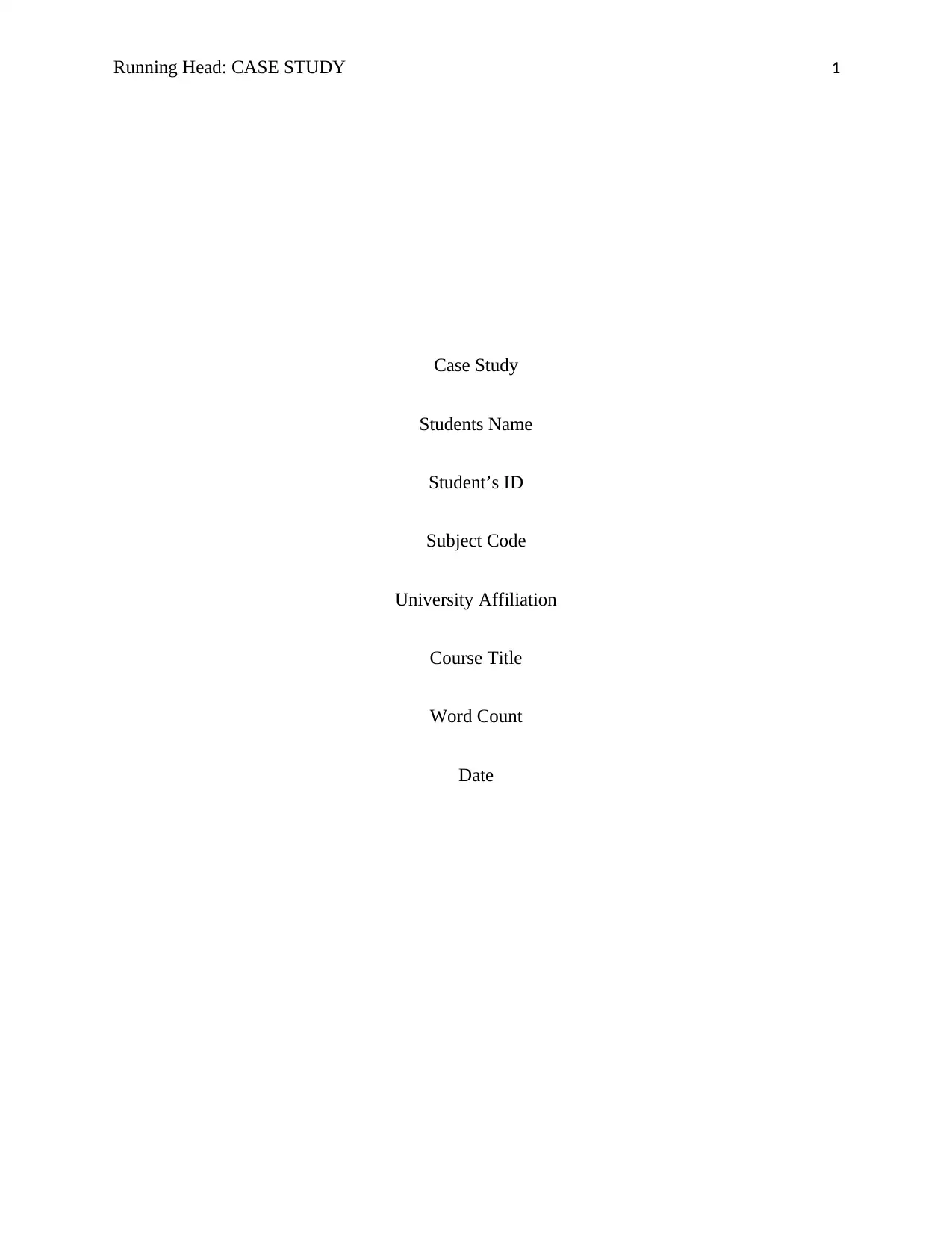
Running Head: CASE STUDY 1
Case Study
Students Name
Student’s ID
Subject Code
University Affiliation
Course Title
Word Count
Date
Case Study
Students Name
Student’s ID
Subject Code
University Affiliation
Course Title
Word Count
Date
Paraphrase This Document
Need a fresh take? Get an instant paraphrase of this document with our AI Paraphraser
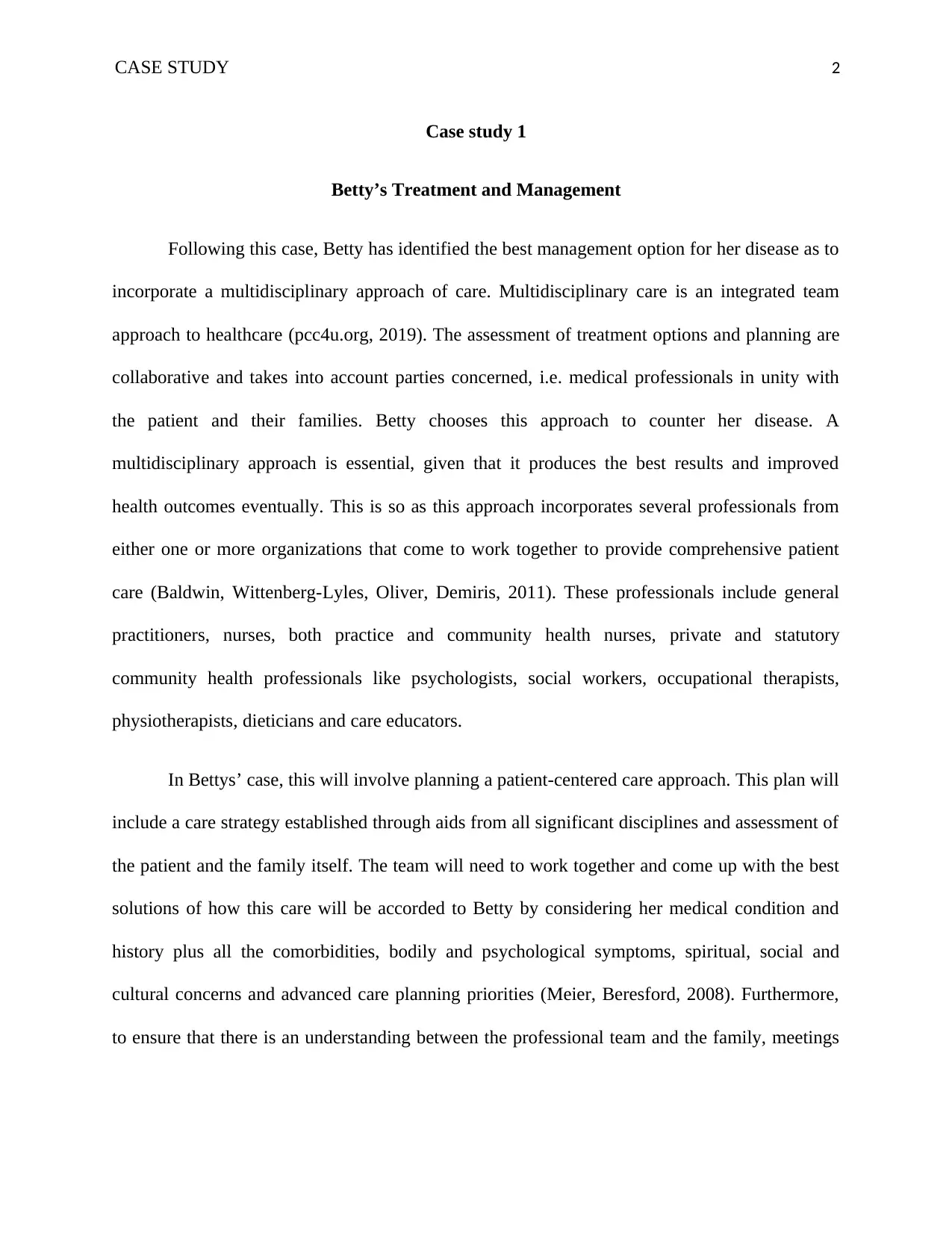
CASE STUDY 2
Case study 1
Betty’s Treatment and Management
Following this case, Betty has identified the best management option for her disease as to
incorporate a multidisciplinary approach of care. Multidisciplinary care is an integrated team
approach to healthcare (pcc4u.org, 2019). The assessment of treatment options and planning are
collaborative and takes into account parties concerned, i.e. medical professionals in unity with
the patient and their families. Betty chooses this approach to counter her disease. A
multidisciplinary approach is essential, given that it produces the best results and improved
health outcomes eventually. This is so as this approach incorporates several professionals from
either one or more organizations that come to work together to provide comprehensive patient
care (Baldwin, Wittenberg-Lyles, Oliver, Demiris, 2011). These professionals include general
practitioners, nurses, both practice and community health nurses, private and statutory
community health professionals like psychologists, social workers, occupational therapists,
physiotherapists, dieticians and care educators.
In Bettys’ case, this will involve planning a patient-centered care approach. This plan will
include a care strategy established through aids from all significant disciplines and assessment of
the patient and the family itself. The team will need to work together and come up with the best
solutions of how this care will be accorded to Betty by considering her medical condition and
history plus all the comorbidities, bodily and psychological symptoms, spiritual, social and
cultural concerns and advanced care planning priorities (Meier, Beresford, 2008). Furthermore,
to ensure that there is an understanding between the professional team and the family, meetings
Case study 1
Betty’s Treatment and Management
Following this case, Betty has identified the best management option for her disease as to
incorporate a multidisciplinary approach of care. Multidisciplinary care is an integrated team
approach to healthcare (pcc4u.org, 2019). The assessment of treatment options and planning are
collaborative and takes into account parties concerned, i.e. medical professionals in unity with
the patient and their families. Betty chooses this approach to counter her disease. A
multidisciplinary approach is essential, given that it produces the best results and improved
health outcomes eventually. This is so as this approach incorporates several professionals from
either one or more organizations that come to work together to provide comprehensive patient
care (Baldwin, Wittenberg-Lyles, Oliver, Demiris, 2011). These professionals include general
practitioners, nurses, both practice and community health nurses, private and statutory
community health professionals like psychologists, social workers, occupational therapists,
physiotherapists, dieticians and care educators.
In Bettys’ case, this will involve planning a patient-centered care approach. This plan will
include a care strategy established through aids from all significant disciplines and assessment of
the patient and the family itself. The team will need to work together and come up with the best
solutions of how this care will be accorded to Betty by considering her medical condition and
history plus all the comorbidities, bodily and psychological symptoms, spiritual, social and
cultural concerns and advanced care planning priorities (Meier, Beresford, 2008). Furthermore,
to ensure that there is an understanding between the professional team and the family, meetings
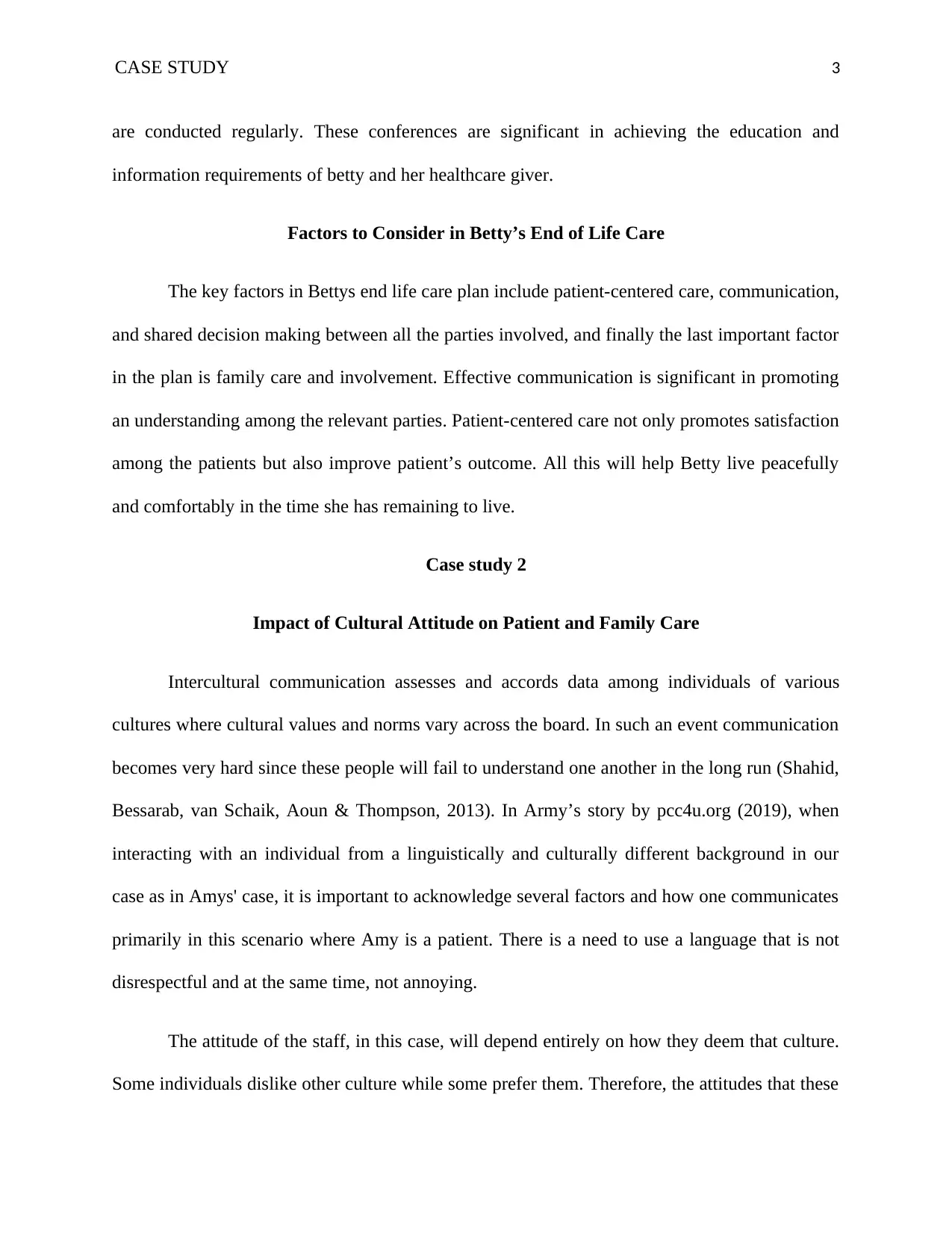
CASE STUDY 3
are conducted regularly. These conferences are significant in achieving the education and
information requirements of betty and her healthcare giver.
Factors to Consider in Betty’s End of Life Care
The key factors in Bettys end life care plan include patient-centered care, communication,
and shared decision making between all the parties involved, and finally the last important factor
in the plan is family care and involvement. Effective communication is significant in promoting
an understanding among the relevant parties. Patient-centered care not only promotes satisfaction
among the patients but also improve patient’s outcome. All this will help Betty live peacefully
and comfortably in the time she has remaining to live.
Case study 2
Impact of Cultural Attitude on Patient and Family Care
Intercultural communication assesses and accords data among individuals of various
cultures where cultural values and norms vary across the board. In such an event communication
becomes very hard since these people will fail to understand one another in the long run (Shahid,
Bessarab, van Schaik, Aoun & Thompson, 2013). In Army’s story by pcc4u.org (2019), when
interacting with an individual from a linguistically and culturally different background in our
case as in Amys' case, it is important to acknowledge several factors and how one communicates
primarily in this scenario where Amy is a patient. There is a need to use a language that is not
disrespectful and at the same time, not annoying.
The attitude of the staff, in this case, will depend entirely on how they deem that culture.
Some individuals dislike other culture while some prefer them. Therefore, the attitudes that these
are conducted regularly. These conferences are significant in achieving the education and
information requirements of betty and her healthcare giver.
Factors to Consider in Betty’s End of Life Care
The key factors in Bettys end life care plan include patient-centered care, communication,
and shared decision making between all the parties involved, and finally the last important factor
in the plan is family care and involvement. Effective communication is significant in promoting
an understanding among the relevant parties. Patient-centered care not only promotes satisfaction
among the patients but also improve patient’s outcome. All this will help Betty live peacefully
and comfortably in the time she has remaining to live.
Case study 2
Impact of Cultural Attitude on Patient and Family Care
Intercultural communication assesses and accords data among individuals of various
cultures where cultural values and norms vary across the board. In such an event communication
becomes very hard since these people will fail to understand one another in the long run (Shahid,
Bessarab, van Schaik, Aoun & Thompson, 2013). In Army’s story by pcc4u.org (2019), when
interacting with an individual from a linguistically and culturally different background in our
case as in Amys' case, it is important to acknowledge several factors and how one communicates
primarily in this scenario where Amy is a patient. There is a need to use a language that is not
disrespectful and at the same time, not annoying.
The attitude of the staff, in this case, will depend entirely on how they deem that culture.
Some individuals dislike other culture while some prefer them. Therefore, the attitudes that these
⊘ This is a preview!⊘
Do you want full access?
Subscribe today to unlock all pages.

Trusted by 1+ million students worldwide
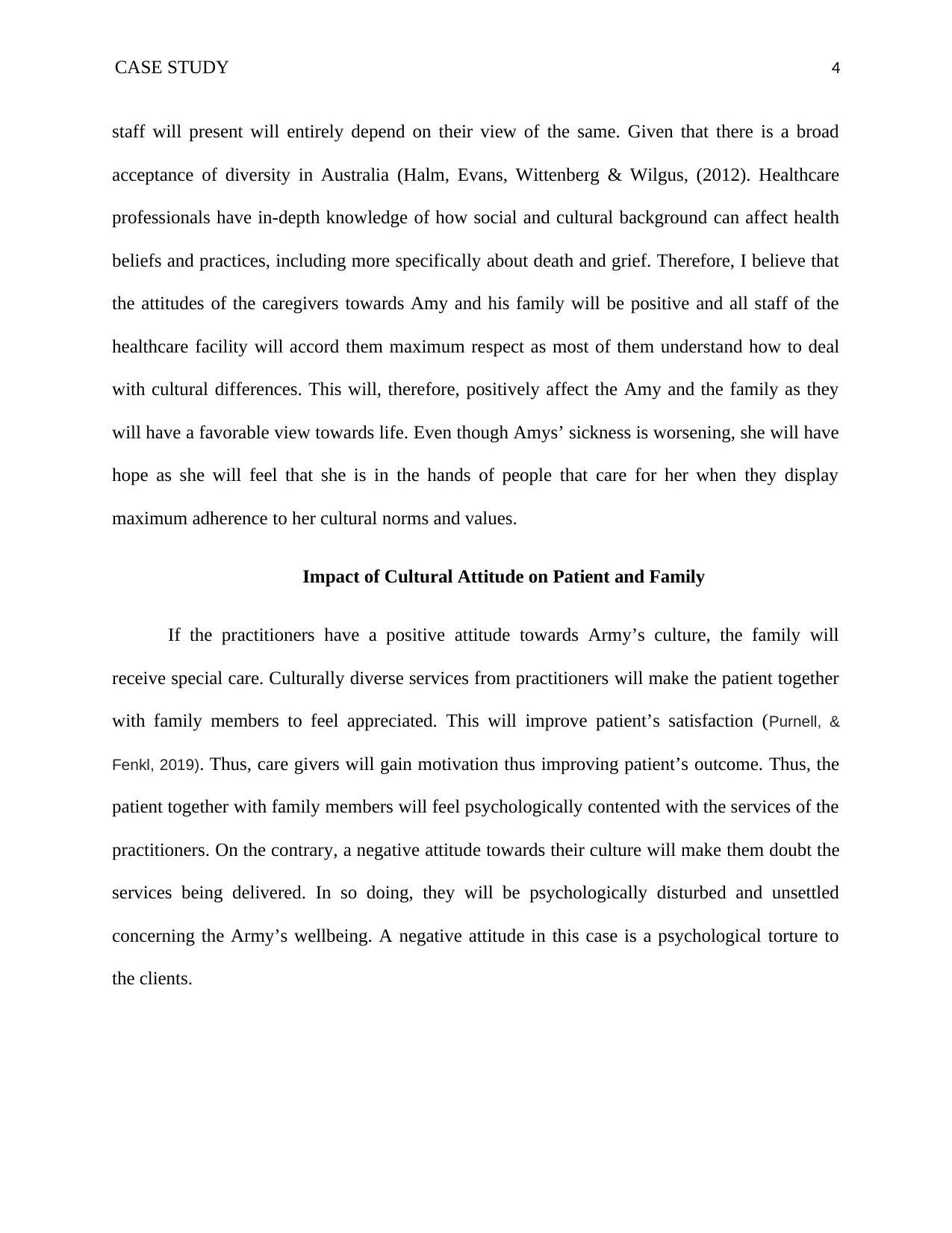
CASE STUDY 4
staff will present will entirely depend on their view of the same. Given that there is a broad
acceptance of diversity in Australia (Halm, Evans, Wittenberg & Wilgus, (2012). Healthcare
professionals have in-depth knowledge of how social and cultural background can affect health
beliefs and practices, including more specifically about death and grief. Therefore, I believe that
the attitudes of the caregivers towards Amy and his family will be positive and all staff of the
healthcare facility will accord them maximum respect as most of them understand how to deal
with cultural differences. This will, therefore, positively affect the Amy and the family as they
will have a favorable view towards life. Even though Amys’ sickness is worsening, she will have
hope as she will feel that she is in the hands of people that care for her when they display
maximum adherence to her cultural norms and values.
Impact of Cultural Attitude on Patient and Family
If the practitioners have a positive attitude towards Army’s culture, the family will
receive special care. Culturally diverse services from practitioners will make the patient together
with family members to feel appreciated. This will improve patient’s satisfaction (Purnell, &
Fenkl, 2019). Thus, care givers will gain motivation thus improving patient’s outcome. Thus, the
patient together with family members will feel psychologically contented with the services of the
practitioners. On the contrary, a negative attitude towards their culture will make them doubt the
services being delivered. In so doing, they will be psychologically disturbed and unsettled
concerning the Army’s wellbeing. A negative attitude in this case is a psychological torture to
the clients.
staff will present will entirely depend on their view of the same. Given that there is a broad
acceptance of diversity in Australia (Halm, Evans, Wittenberg & Wilgus, (2012). Healthcare
professionals have in-depth knowledge of how social and cultural background can affect health
beliefs and practices, including more specifically about death and grief. Therefore, I believe that
the attitudes of the caregivers towards Amy and his family will be positive and all staff of the
healthcare facility will accord them maximum respect as most of them understand how to deal
with cultural differences. This will, therefore, positively affect the Amy and the family as they
will have a favorable view towards life. Even though Amys’ sickness is worsening, she will have
hope as she will feel that she is in the hands of people that care for her when they display
maximum adherence to her cultural norms and values.
Impact of Cultural Attitude on Patient and Family
If the practitioners have a positive attitude towards Army’s culture, the family will
receive special care. Culturally diverse services from practitioners will make the patient together
with family members to feel appreciated. This will improve patient’s satisfaction (Purnell, &
Fenkl, 2019). Thus, care givers will gain motivation thus improving patient’s outcome. Thus, the
patient together with family members will feel psychologically contented with the services of the
practitioners. On the contrary, a negative attitude towards their culture will make them doubt the
services being delivered. In so doing, they will be psychologically disturbed and unsettled
concerning the Army’s wellbeing. A negative attitude in this case is a psychological torture to
the clients.
Paraphrase This Document
Need a fresh take? Get an instant paraphrase of this document with our AI Paraphraser
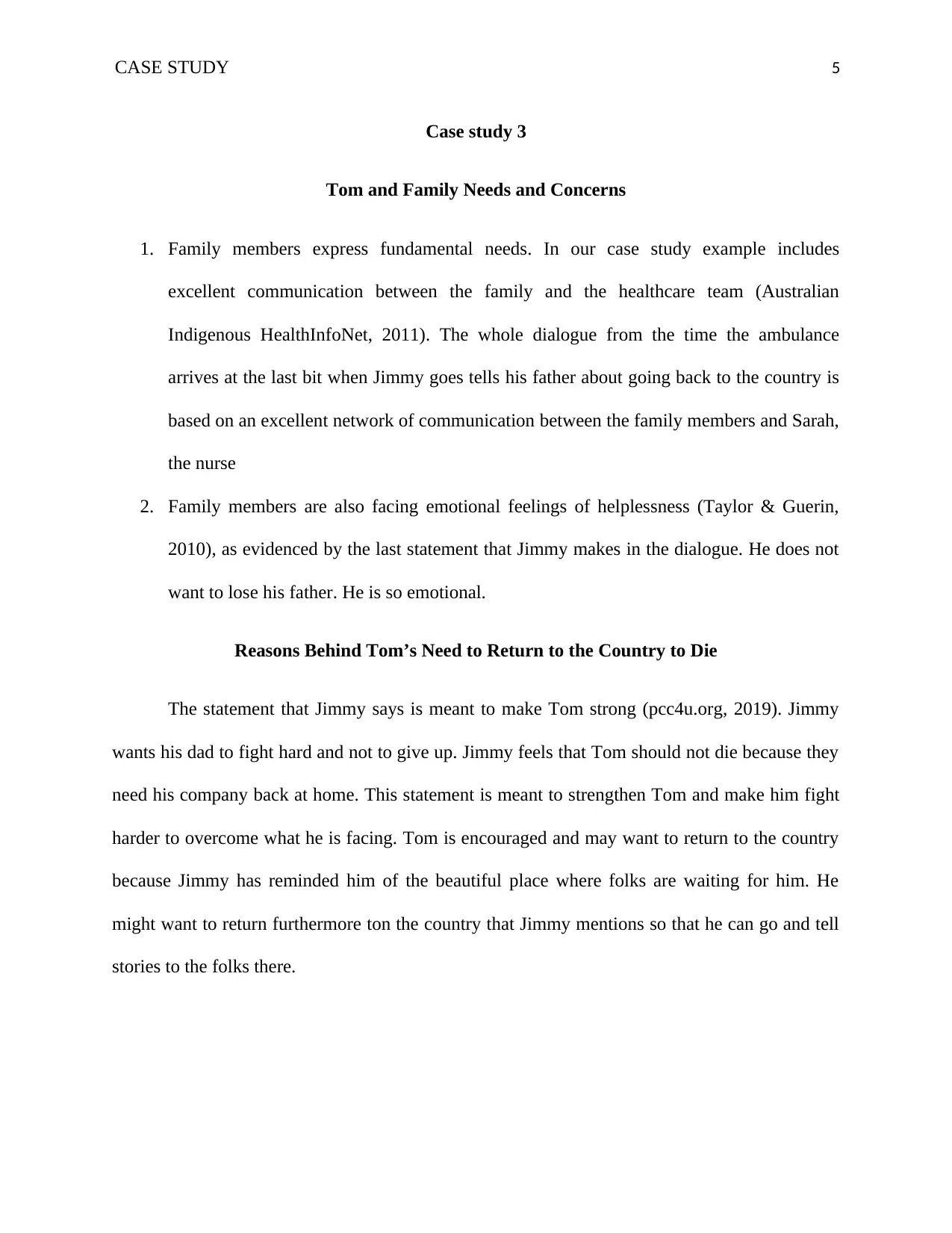
CASE STUDY 5
Case study 3
Tom and Family Needs and Concerns
1. Family members express fundamental needs. In our case study example includes
excellent communication between the family and the healthcare team (Australian
Indigenous HealthInfoNet, 2011). The whole dialogue from the time the ambulance
arrives at the last bit when Jimmy goes tells his father about going back to the country is
based on an excellent network of communication between the family members and Sarah,
the nurse
2. Family members are also facing emotional feelings of helplessness (Taylor & Guerin,
2010), as evidenced by the last statement that Jimmy makes in the dialogue. He does not
want to lose his father. He is so emotional.
Reasons Behind Tom’s Need to Return to the Country to Die
The statement that Jimmy says is meant to make Tom strong (pcc4u.org, 2019). Jimmy
wants his dad to fight hard and not to give up. Jimmy feels that Tom should not die because they
need his company back at home. This statement is meant to strengthen Tom and make him fight
harder to overcome what he is facing. Tom is encouraged and may want to return to the country
because Jimmy has reminded him of the beautiful place where folks are waiting for him. He
might want to return furthermore ton the country that Jimmy mentions so that he can go and tell
stories to the folks there.
Case study 3
Tom and Family Needs and Concerns
1. Family members express fundamental needs. In our case study example includes
excellent communication between the family and the healthcare team (Australian
Indigenous HealthInfoNet, 2011). The whole dialogue from the time the ambulance
arrives at the last bit when Jimmy goes tells his father about going back to the country is
based on an excellent network of communication between the family members and Sarah,
the nurse
2. Family members are also facing emotional feelings of helplessness (Taylor & Guerin,
2010), as evidenced by the last statement that Jimmy makes in the dialogue. He does not
want to lose his father. He is so emotional.
Reasons Behind Tom’s Need to Return to the Country to Die
The statement that Jimmy says is meant to make Tom strong (pcc4u.org, 2019). Jimmy
wants his dad to fight hard and not to give up. Jimmy feels that Tom should not die because they
need his company back at home. This statement is meant to strengthen Tom and make him fight
harder to overcome what he is facing. Tom is encouraged and may want to return to the country
because Jimmy has reminded him of the beautiful place where folks are waiting for him. He
might want to return furthermore ton the country that Jimmy mentions so that he can go and tell
stories to the folks there.
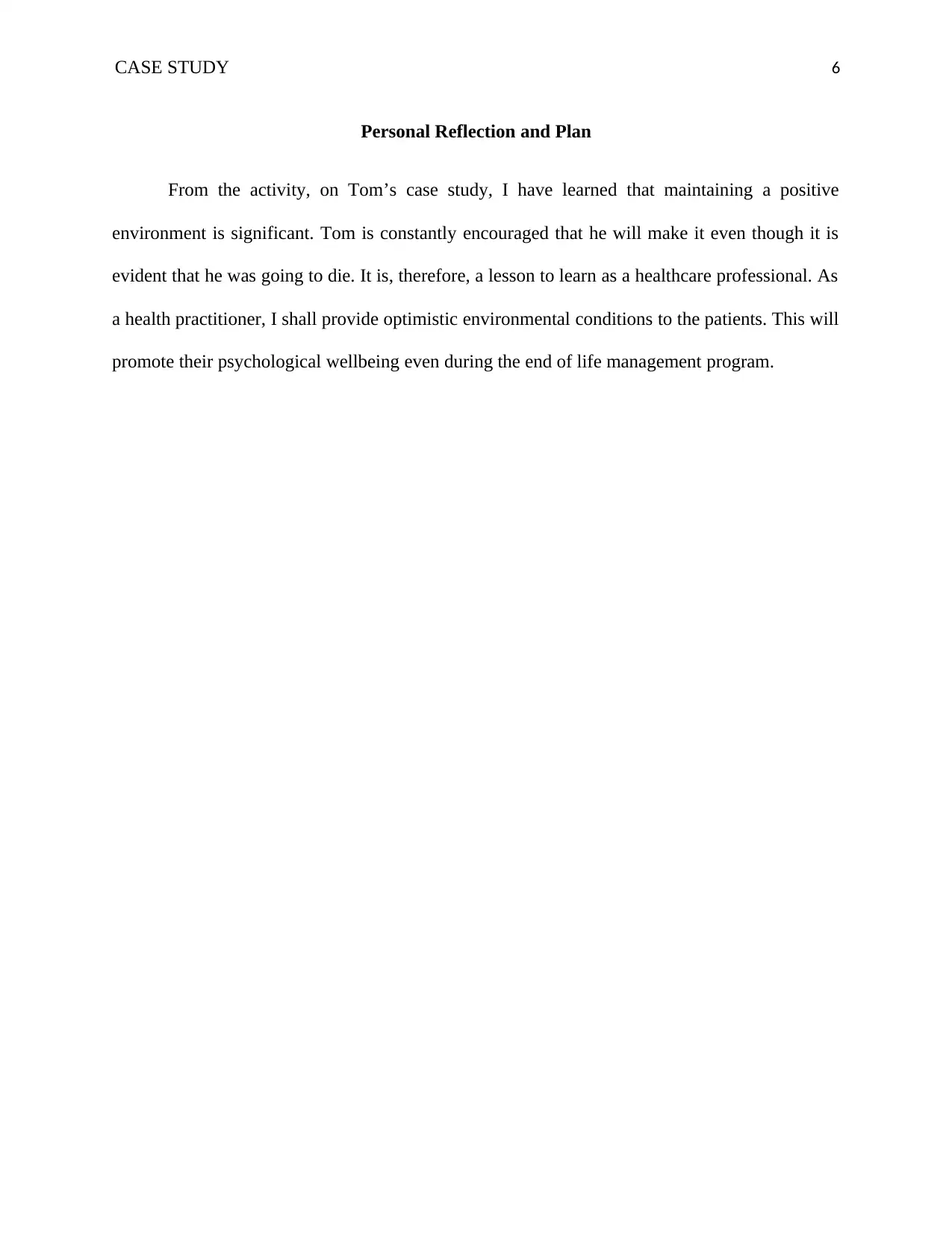
CASE STUDY 6
Personal Reflection and Plan
From the activity, on Tom’s case study, I have learned that maintaining a positive
environment is significant. Tom is constantly encouraged that he will make it even though it is
evident that he was going to die. It is, therefore, a lesson to learn as a healthcare professional. As
a health practitioner, I shall provide optimistic environmental conditions to the patients. This will
promote their psychological wellbeing even during the end of life management program.
Personal Reflection and Plan
From the activity, on Tom’s case study, I have learned that maintaining a positive
environment is significant. Tom is constantly encouraged that he will make it even though it is
evident that he was going to die. It is, therefore, a lesson to learn as a healthcare professional. As
a health practitioner, I shall provide optimistic environmental conditions to the patients. This will
promote their psychological wellbeing even during the end of life management program.
⊘ This is a preview!⊘
Do you want full access?
Subscribe today to unlock all pages.

Trusted by 1+ million students worldwide
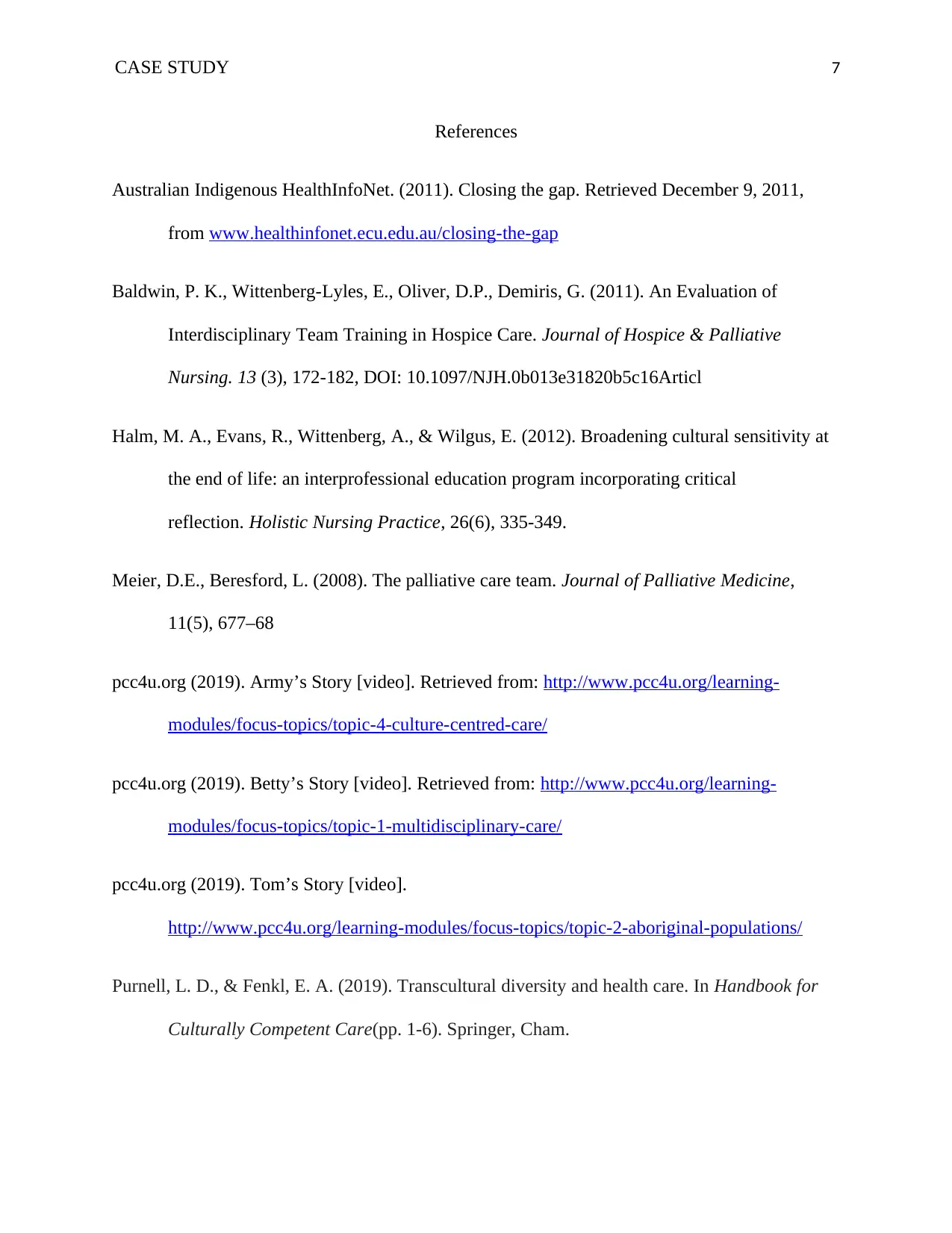
CASE STUDY 7
References
Australian Indigenous HealthInfoNet. (2011). Closing the gap. Retrieved December 9, 2011,
from www.healthinfonet.ecu.edu.au/closing-the-gap
Baldwin, P. K., Wittenberg-Lyles, E., Oliver, D.P., Demiris, G. (2011). An Evaluation of
Interdisciplinary Team Training in Hospice Care. Journal of Hospice & Palliative
Nursing. 13 (3), 172-182, DOI: 10.1097/NJH.0b013e31820b5c16Articl
Halm, M. A., Evans, R., Wittenberg, A., & Wilgus, E. (2012). Broadening cultural sensitivity at
the end of life: an interprofessional education program incorporating critical
reflection. Holistic Nursing Practice, 26(6), 335-349.
Meier, D.E., Beresford, L. (2008). The palliative care team. Journal of Palliative Medicine,
11(5), 677–68
pcc4u.org (2019). Army’s Story [video]. Retrieved from: http://www.pcc4u.org/learning-
modules/focus-topics/topic-4-culture-centred-care/
pcc4u.org (2019). Betty’s Story [video]. Retrieved from: http://www.pcc4u.org/learning-
modules/focus-topics/topic-1-multidisciplinary-care/
pcc4u.org (2019). Tom’s Story [video].
http://www.pcc4u.org/learning-modules/focus-topics/topic-2-aboriginal-populations/
Purnell, L. D., & Fenkl, E. A. (2019). Transcultural diversity and health care. In Handbook for
Culturally Competent Care(pp. 1-6). Springer, Cham.
References
Australian Indigenous HealthInfoNet. (2011). Closing the gap. Retrieved December 9, 2011,
from www.healthinfonet.ecu.edu.au/closing-the-gap
Baldwin, P. K., Wittenberg-Lyles, E., Oliver, D.P., Demiris, G. (2011). An Evaluation of
Interdisciplinary Team Training in Hospice Care. Journal of Hospice & Palliative
Nursing. 13 (3), 172-182, DOI: 10.1097/NJH.0b013e31820b5c16Articl
Halm, M. A., Evans, R., Wittenberg, A., & Wilgus, E. (2012). Broadening cultural sensitivity at
the end of life: an interprofessional education program incorporating critical
reflection. Holistic Nursing Practice, 26(6), 335-349.
Meier, D.E., Beresford, L. (2008). The palliative care team. Journal of Palliative Medicine,
11(5), 677–68
pcc4u.org (2019). Army’s Story [video]. Retrieved from: http://www.pcc4u.org/learning-
modules/focus-topics/topic-4-culture-centred-care/
pcc4u.org (2019). Betty’s Story [video]. Retrieved from: http://www.pcc4u.org/learning-
modules/focus-topics/topic-1-multidisciplinary-care/
pcc4u.org (2019). Tom’s Story [video].
http://www.pcc4u.org/learning-modules/focus-topics/topic-2-aboriginal-populations/
Purnell, L. D., & Fenkl, E. A. (2019). Transcultural diversity and health care. In Handbook for
Culturally Competent Care(pp. 1-6). Springer, Cham.
Paraphrase This Document
Need a fresh take? Get an instant paraphrase of this document with our AI Paraphraser
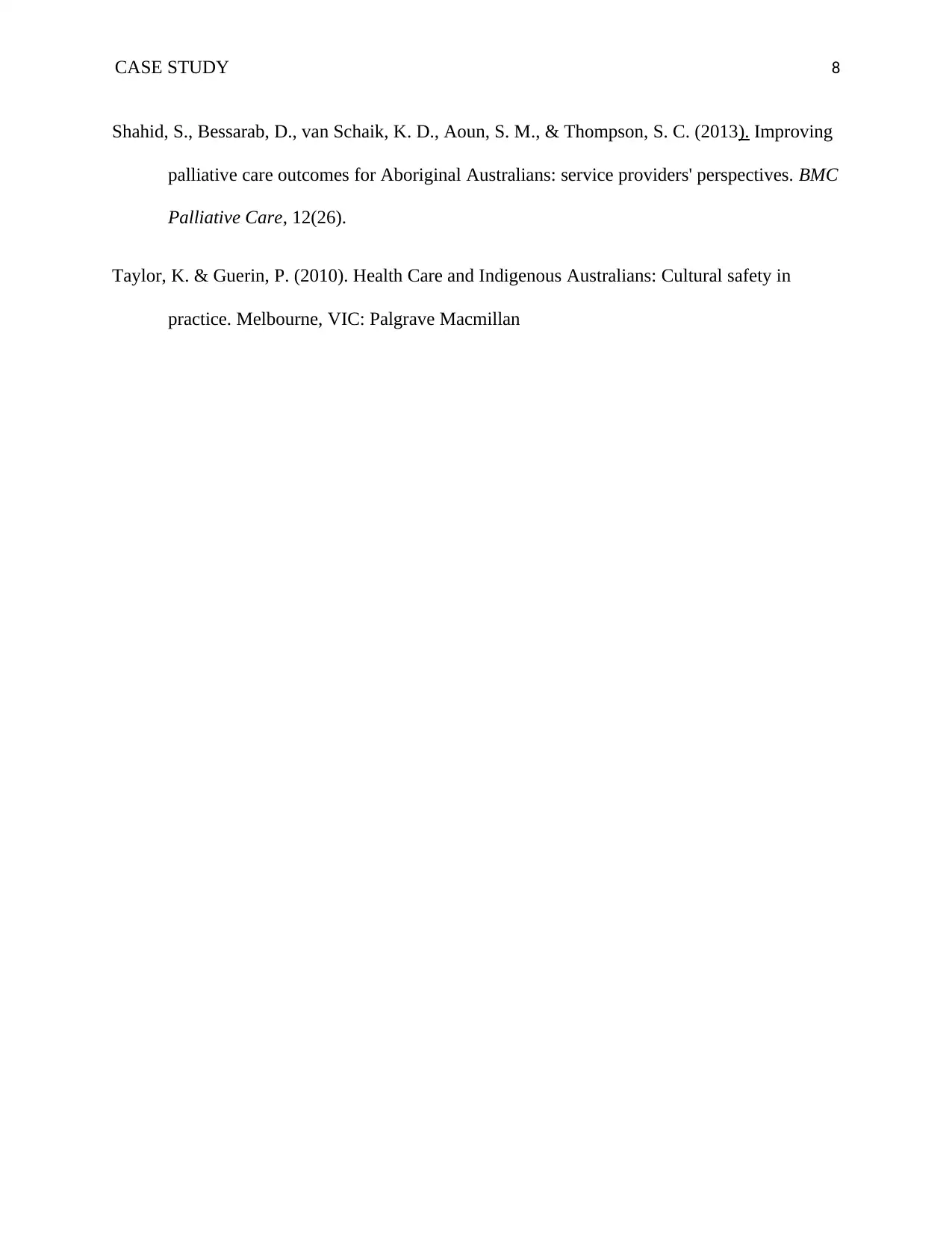
CASE STUDY 8
Shahid, S., Bessarab, D., van Schaik, K. D., Aoun, S. M., & Thompson, S. C. (2013). Improving
palliative care outcomes for Aboriginal Australians: service providers' perspectives. BMC
Palliative Care, 12(26).
Taylor, K. & Guerin, P. (2010). Health Care and Indigenous Australians: Cultural safety in
practice. Melbourne, VIC: Palgrave Macmillan
Shahid, S., Bessarab, D., van Schaik, K. D., Aoun, S. M., & Thompson, S. C. (2013). Improving
palliative care outcomes for Aboriginal Australians: service providers' perspectives. BMC
Palliative Care, 12(26).
Taylor, K. & Guerin, P. (2010). Health Care and Indigenous Australians: Cultural safety in
practice. Melbourne, VIC: Palgrave Macmillan
1 out of 8
Related Documents
Your All-in-One AI-Powered Toolkit for Academic Success.
+13062052269
info@desklib.com
Available 24*7 on WhatsApp / Email
![[object Object]](/_next/static/media/star-bottom.7253800d.svg)
Unlock your academic potential
Copyright © 2020–2025 A2Z Services. All Rights Reserved. Developed and managed by ZUCOL.





